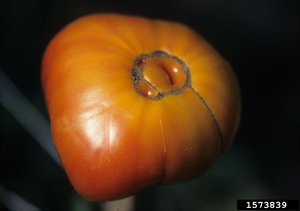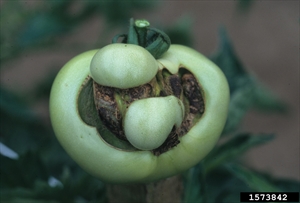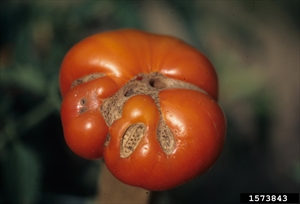Tomato catface
Pacific Pests, Pathogens and Weeds - Online edition
Pacific Pests, Pathogens & Weeds
Tomato catface (420)
None; a physiological disorder.
Likely in all the countries where tomatoes are grown.
Tomato
Catface is a general term that applies to tomato fruit that are deformed, mostly at the blossom end (Photo 1). In severe cases, there are lumps, outgrowths, and holes over large parts of the fruit (Photos 2-5). There is usually large areas of scar tissue surrounding or between the deformed or misshaped parts (Photos 2,4&5). The fruit itself is still edible, just unsightly.
It is a physiological conditions, i.e., not caused by a pest or disease. It is most common on larger varieties. But the cause of catface is not well understood. Generally, it is thought to be caused by any condition that causes irregular growth during blossom initiation. Some varieties are more susceptible than others.
The following causes have been suggested:
- Initial growth during a dry period followed by a period of heavy rain or irrigation.
- Alternating dry and wet soil conditions.
- Cold (<10°C at night) during flowering.
- Large fluctuations of night and day temperatures.
- Excessive amounts of N fertiliser.
- Thrips damaging the female parts of the flower.
- Excessive pruning of indeterminate varieties; this is because excessive pruning may lower auxin in the plant.
- Use of 2,4-D.
Catface symptoms most commonly occur at the blossom end of the fruit, but it can also occur on the side of the fruit.
Catface is a common problem, especially on varieties with large fruits. Losses are not well reported, so impact not known.
Look for deformed fruit - lumps, outgrowths, holes and scaring - most obvious at the blossom end of the fruit.
CULTURAL CONTROL
To prevent catface, there are a number of cultural practices that can be tried, but they should be used in combination with tolerant varieties.
-
Avoid excessive pruning.
- Avoid excessive nitrogen fertilization.
- Avoid planting in seasons when low temperature (less than 10°C) may be expected.
- Avoid extremes of wet and dry.
- Use varieties that are less prone to catface.
- Use a mulch.
RESISTANT VARIETIES
This is the most important way to manage the problem. Choose a variety that is said to tolerate the disorder. In the USA, the following are said to have tolerance: Duke, Count II, Floradade, Homestead, Walter. In general, the 'older' varieties show less of the disorder than plum and cherry varieties.
CHEMICAL CONTROL
Not a method of control for this disorder.
AUTHOR Grahame Jackson
Information from tomato, cat facing. University of Massachusetts Amherst. (https://ag.umass.edu/vegetable/fact-sheets/tomato-cat-facing); and from Tomato diseases (undated) Catface. UF/IFAS. University of Florida. Photo 1. Union Square Green Market (https://www.instagram.com/p/BIVuBCKhuDf/?utm_source=ig_embed). Photos 2,4&5 Gerald Holmes, California Polytechnic State University at San Luis Obispo. Photo 3 M.E. Bartolo, Bugwood.org.
Produced with support from the Australian Centre for International Agricultural Research under project HORT/2016/185: Responding to emerging pest and disease threats to horticulture in the Pacific islands, implemented by the University of Queensland and the Secretariat of the Pacific Community.








